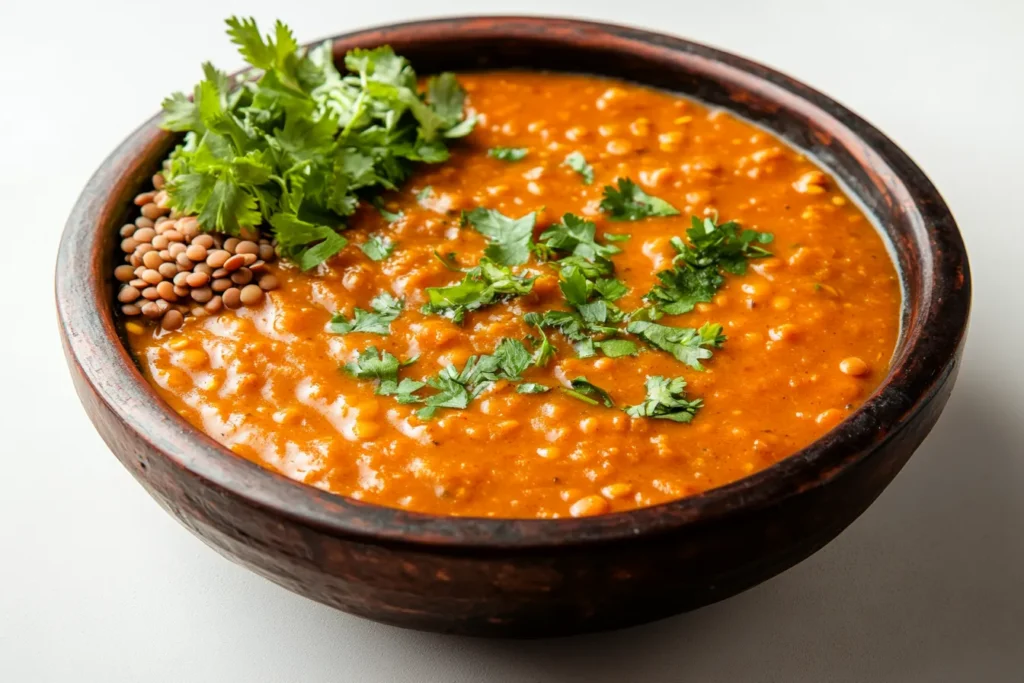Have you ever found yourself staring at your pantry, wondering what to make for dinner? Red lentils might just be the answer you’ve been looking for. They’re quick to cook, packed with nutrients, and incredibly versatile—perfect for soups, stews, and so much more. If you’re looking for an easy way to create hearty, flavorful meals without spending hours in the kitchen, red lentils are your secret weapon. Let’s explore how you can use this humble ingredient to transform your cooking.
List Of Contents
Introduction to Red Lentils
Red lentils are a versatile and nutritious ingredient, often found in kitchens worldwide. Known for their quick cooking time and ability to blend seamlessly into dishes, they are especially popular in soups, stews, and curries. Unlike their green or brown counterparts, red lentils are hulled, which means their outer seed coat is removed. This process makes them softer and allows them to break down into a creamy texture when cooked.
Their origins trace back to ancient Middle Eastern and Indian cuisines, where they have been a dietary staple for centuries. Today, they are cherished for their nutritional benefits and ease of preparation, making them an excellent choice for both beginners and seasoned cooks. Check out more recipes here.

Nutritional Benefits of Red Lentils
Red lentils are packed with nutrients that contribute to a balanced diet. Here are some of their key benefits:
- High in protein, making them a valuable source of plant-based nutrition.
- Rich in dietary fiber, which aids digestion and promotes heart health.
- Contains essential vitamins and minerals like folate, magnesium, and iron.
- Low in fat and cholesterol, making them ideal for healthy eating.
With their combination of protein and fiber, red lentils are particularly good for maintaining energy levels and keeping you full for longer periods. check out more recipes here.
Red Lentils vs. Other Lentil Varieties: Key Differences
Red lentils differ significantly from other lentil varieties like green, brown, or black lentils. These differences make them unique in their culinary applications:
- Appearance: Red lentils have a vibrant orange-red color, while other varieties are green, brown, or black.
- Cooking Time: Red lentils cook faster, usually within 15–20 minutes, compared to 30–40 minutes for green or brown lentils.
- Texture: Red lentils become soft and creamy when cooked, whereas green or brown lentils retain their shape and firm texture.
- Flavor: They have a mild, slightly sweet flavor that complements a wide range of dishes.
- Uses: Red lentils are ideal for soups and purees, while green and brown lentils are better suited for salads and hearty stews.
Why Soaking is Essential for Some Lentil Types
For many legumes, soaking is an important preparation step. It serves several purposes:
- Softens the lentils, reducing cooking time significantly.
- Helps break down phytic acid, which can inhibit nutrient absorption.
- Removes dirt, debris, and any anti-nutrients present on the lentils’ surface.
However, not all lentil varieties require soaking. For example, green and brown lentils benefit from soaking, especially when used in salads or firm dishes. But what about red lentils?
The Unique Properties of Red Lentils
Red lentils are hulled, meaning their outer layer is removed. This allows them to cook faster and makes them more digestible. Unlike green or brown lentils, red lentils do not require soaking. Instead, they only need to be rinsed to remove surface dust and starches. Rinsing also helps eliminate any residue from processing. check out more recipes here.
Water Absorption Rates in Red Lentils
Red lentils absorb water quickly during cooking, which contributes to their soft, creamy texture. This rapid absorption makes them ideal for recipes where a smooth consistency is desired. check out more recipes here.
How Soaking Affects Cooking Time
Comparing Cooking Times: Soaked vs. Unsoaked Red Lentils
While soaking reduces the cooking time for many legumes, it has minimal impact on red lentils due to their soft, hulled nature. Here’s a comparison:
| Preparation Type | Cooking Time | Notes |
|---|---|---|
| Unsoaked | 15–20 minutes | Retains some texture. |
| Soaked | 10–15 minutes | Creamier consistency. |
The difference is small, but soaking may still be helpful if you want to ensure even softer results.
Does Soaking Improve Digestibility?
For some people, soaking lentils makes them easier to digest. Soaking helps break down certain compounds that can cause gas or bloating. Although red lentils are naturally easier on the stomach, soaking for 10–15 minutes may further improve digestibility for those with sensitive stomachs.
Cooking Red Lentils: Techniques and Tips
Preparing Red Lentils for Soup
Red lentils are incredibly simple to prepare, making them a go-to ingredient for quick, healthy meals. Proper preparation ensures that their flavors and textures shine, especially in soups. Here are the essential steps for preparing red lentils before cooking.
Washing and Cleaning Red Lentils
Before cooking, it is crucial to rinse red lentils thoroughly. This step removes any surface dust, starch, or debris. Here’s how to do it:
- Place the lentils in a sieve or bowl.
- Run cold water over them while stirring gently.
- Continue rinsing until the water runs clear.
Rinsing ensures your lentils cook evenly and prevents any off-flavors or excess foam from forming during cooking.
To Soak or Not to Soak? A Detailed Analysis
Red lentils are unique because they do not require soaking due to their hull-less structure. However, there are scenarios where soaking may be beneficial:
- Soaking can slightly reduce cooking time, making them even quicker to prepare.
- It can improve digestibility, especially for those with sensitive stomachs.
- It helps achieve an ultra-smooth consistency in soups or purees.
For most recipes, rinsing is sufficient, but a quick 10-minute soak may be useful if you’re aiming for a softer or creamier dish.
The Science of Cooking Red Lentils
Understanding the scientific properties of red lentils can help you perfect your cooking technique. Their unique structure and starch composition allow them to transform from firm legumes to a creamy base quickly.
Understanding Red Lentil Starch
Red lentils are rich in starch, which contributes to their creamy texture when cooked. This starch is released as the lentils absorb water and break down. The result is a thick, velvety consistency, ideal for soups and stews.

Key considerations when working with red lentil starch:
- Cook them gently to avoid over-thickening.
- Stir occasionally to prevent sticking but avoid over-stirring, which can make the soup overly starchy.
How Temperature Affects Lentil Texture
Temperature plays a critical role in determining the texture of red lentils. Cooking at a high temperature can cause the lentils to split unevenly, leading to inconsistent textures. On the other hand, simmering them at a moderate heat allows for even cooking and better absorption of flavors.
For the best results:
- Bring the lentils to a boil, then reduce the heat to a gentle simmer.
- Cover the pot partially to retain moisture while allowing some evaporation.
Cooking red lentils is straightforward, but even experienced cooks can encounter a few challenges. Here are the most common mistakes and how to avoid them.
Overcooking and Its Impact
Red lentils cook quickly, so leaving them on the heat for too long can lead to a mushy, overly thick consistency. While this texture is fine for purees, it may not be ideal for chunky soups or stews.
To prevent overcooking:
- Set a timer for 15–20 minutes and check the lentils periodically.
- Remove from heat as soon as they reach your desired consistency.
Adding Acidic Ingredients Too Early
Acidic ingredients, such as tomatoes, lemon juice, or vinegar, can interfere with the cooking process. They slow down the softening of lentils, making them harder to cook through.
To avoid this issue:
- Add acidic ingredients only after the lentils are fully cooked.
- If your recipe calls for a tangy flavor, consider using mild acids like yogurt or coconut milk instead.
Cooking Red Lentils Perfectly for Soups
To master red lentil soup, follow these tips:
- Use a 3:1 liquid-to-lentil ratio for a creamy base.
- Add spices early in the cooking process to infuse flavor.
- Stir occasionally but avoid vigorous stirring, which can cause lentils to break down too much.
Red Lentil Soup Recipes and Variations
Red lentil soup is a versatile dish, adapting well to various global cuisines and personal preferences. Whether you prefer a simple, comforting bowl or a vibrant, spice-infused variation, red lentil soup offers endless possibilities.
Classic Red Lentil Soup
The classic version of red lentil soup is a comforting, hearty dish. It relies on a few basic ingredients and straightforward preparation steps.
Ingredients and Preparation Steps
Ingredients:
- 1 cup red lentils (rinsed and drained)
- 1 medium onion, chopped
- 2 medium carrots, diced
- 3 garlic cloves, minced
- 4 cups vegetable stock or water
- 1 tablespoon olive oil
- 1 teaspoon ground cumin
- 1/2 teaspoon turmeric
- Salt and pepper to taste
- Optional: Lemon wedges and fresh parsley for garnish
Preparation:
- Heat olive oil in a large pot over medium heat.
- Add onion, garlic, and carrots. Sauté until softened and fragrant.
- Add cumin and turmeric, then cook for an additional minute to enhance their flavors.
- Add red lentils and stock. Heat until it reaches a boil, then lower the temperature to let it simmer.
- Cook for 15–20 minutes, stirring occasionally, until the lentils are soft and creamy.
- Season with salt and pepper.
Optionally, puree part of the soup for a smoother consistency. - Serve hot, garnished with parsley and a squeeze of lemon.
Flavor Variations
To elevate the classic recipe, try incorporating these flavor additions:
- Include a dash of smoked paprika for a smoky flavor.
- Use coconut milk instead of some of the stock for a richer, creamier base.
- Include a dash of cayenne pepper or chili flakes for a spicy kick.
Global Takes on Red Lentil Soup
Red lentil soup adapts beautifully to the flavors and techniques of different cuisines. Here are three popular global variations.

Middle Eastern lentil soup is light, tangy, and aromatic:
Key Ingredients:
- Lemon juice for tanginess
- Ground cumin and coriander for warmth
- Garlic for depth
- Olive oil for richness
Simmer red lentils with garlic and spices, then finish with fresh lemon juice. Serve with warm pita bread or a drizzle of tahini for an authentic touch.
Indian Dal-Inspired Red Lentil Soup
Key Ingredients:
- Ghee or coconut oil as the cooking base
- Mustard seeds, curry leaves, and turmeric for authentic flavors
- Garam masala for complexity
- Coconut milk for creaminess
Start by tempering mustard seeds and curry leaves in hot ghee. Add red lentils and cook with spices, finishing with coconut milk for a rich, satisfying bowl.
Mediterranean Lentil Soup with Vegetables
Mediterranean red lentil soup is fresh and packed with vegetables.
Key Ingredients:
- Zucchini, tomatoes, and spinach for a colorful mix
- Fresh basil and oregano for herbal notes
- Olive oil for a smooth finish
This version highlights the natural sweetness of lentils, balanced by the acidity of tomatoes and the brightness of fresh herbs.
Tips for Enhancing Soup Texture and Flavor
Mastering the art of red lentil soup involves paying attention to key elements like liquid choices, cooking techniques, and final touches.
Using Stock vs. Water
The choice of liquid impacts the depth of flavor in your soup:
- Vegetable or Chicken Stock: Enhances richness and adds layers of flavor.
- Water: A neutral option that allows the lentils’ natural taste to shine.
For the best results, use low-sodium stock so you can control the salt levels during cooking.
Garnishes and Final Touches
Garnishes not only enhance the soup’s presentation but also add complementary flavors and textures:
- Crunchy Toppings: Use toasted nuts, croutons, or fried onions for added texture.
- Creamy Swirls: Add a dollop of yogurt, sour cream, or coconut milk for extra richness.
- Herbal Brightness: Finish with freshly chopped parsley, cilantro, or dill for a pop of freshness.
- Citrus Zest: A squeeze of lemon or lime juice can brighten the flavors.
FAQs
1. Can I use red lentils for cold soups?
Yes, red lentils work well in cold soups when blended into a creamy consistency.
2. Are red lentils suitable for meal prep?
Absolutely. Cooked red lentil soup can be refrigerated for up to 5 days or frozen for 3 months.
3. Can I mix red lentils with other lentil varieties in soups?
Yes, combining lentils adds varied textures and flavors.
4. Do red lentils need to be soaked overnight?
No, red lentils do not require soaking, but a quick rinse is recommended.
5. Can I cook red lentil soup in a pressure cooker?
Yes, pressure cookers can significantly reduce cooking time.
6. Are red lentils high in protein?
Yes, red lentils are an excellent plant-based protein source.
7. Do red lentils lose their color when cooked?
Yes, they often change from red to a golden-yellow hue during cooking.
8. How do I prevent lentils from sticking to the pot?
Simmer on a low flame and stir now and then to avoid sticking.
9. Can I use dried herbs instead of fresh in red lentil soup?
Yes, but reduce the quantity, as dried herbs are more concentrated.
10. What is the best way to reheat red lentil soup?
Reheat gently on the stovetop, adding a splash of water or stock to restore consistency.
